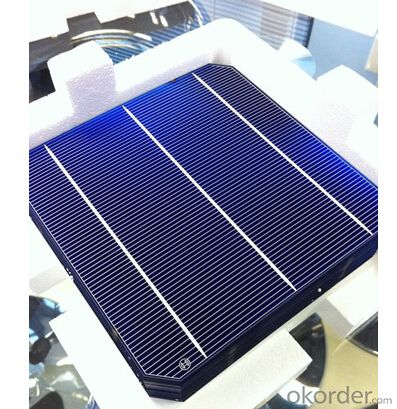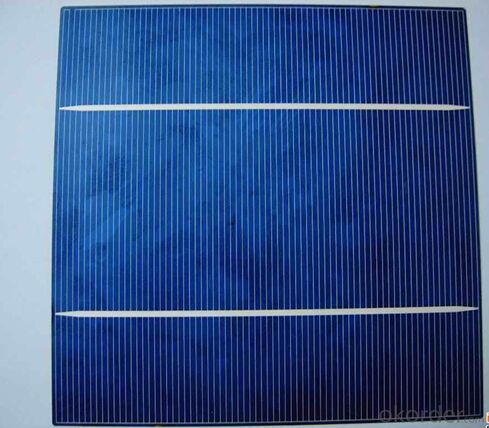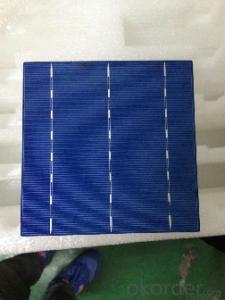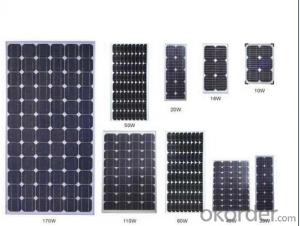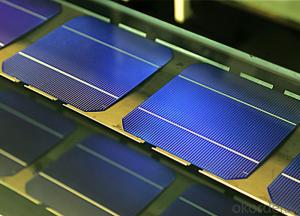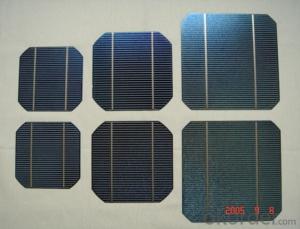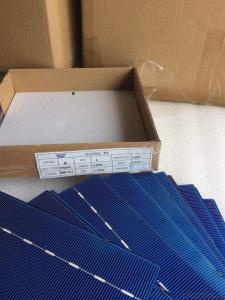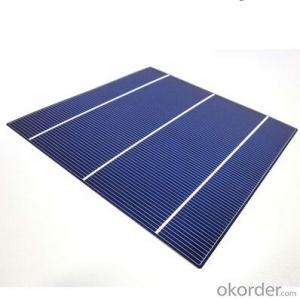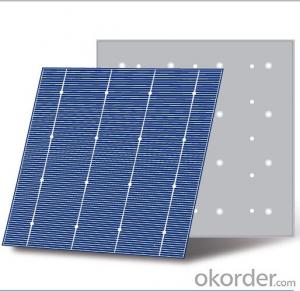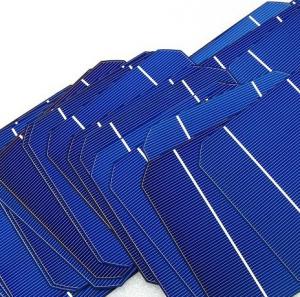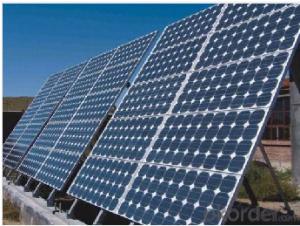C Si Solar Cells - 25 Years Life Time - 17.8% Efficiency - World-Beating Performance
- Loading Port:
- Shanghai
- Payment Terms:
- TT OR LC
- Min Order Qty:
- 1000 pc
- Supply Capability:
- 5000000 pc/month
OKorder Service Pledge
OKorder Financial Service
You Might Also Like
Brief Introduction of Solar Cells
A solar cell, is an electrical device that converts the energy of light directly into electricity by the photovoltaic effect, which is a physical and chemical phenomenon. It is a form of photoelectric cell, defined as a device whose electrical characteristics, such as current, voltage, or resistance, vary when exposed to light. Solar cells are the building blocks of photovoltaic modules, otherwise known as solar panels.
Introduction of our Company
We are a producer of bifacial photovoltaic (PV) crystalline silicon solar cells that provide 25% and beyond more electricity per cell at a standard cell production cost, lowering the LCOE, doubling the PV project IRR and cutting its payback time.
Our bifacial cell delivers industry leading equivalent cell efficiency with over 21% today and a target of over 24% in the near future. Our cell is the best solution for flat rooftop and ground installations, as well as for PV trackers, sound barriers, car ports, facades and some forms of BIPV.
Our manufactures its bifacial high-performance, high-quality, mono c-si cells in its 30 MWp/year plant in Heilbronn, Germany and is on track with a four-year target of reaching a bifacial cell production capacity of 500 MW/year worldwide.
The PV market has turned into a commodity market where most vendors offer similar products without differentiation. Cell efficiencies are reaching a ceiling and current players are only able to offer marginal improvements through higher production costs. Our bifacial cell offers a disruptive solution targeted at the mainstream of the PV value chain; p-type, 6’’ silicon cells, with an unprecedented combination of high efficiency and low production cost.
Specifications of Polycrystalline Solar Cells
Format: 156 mm × 156 mm ± 0.5 mm
Thickness: 210 μm ±40 μm
Front (-) : 1.5mm bus bars (silver),blue anti-reflection coating (silicon nitride)
Back (+) : 2.5mm wide soldering pads (silver) back surface field (aluminium)
Efficiency (%) | Pmpp (W) | Umpp (V) | Impp (A) | Voc (V) | Isc (A) |
18.00% | 4.38 | 0.528 | 8.291 | 0.631 | 8.869 |
17.80% | 4.33 | 0.525 | 8.252 | 0.629 | 8.821 |
17.60% | 4.29 | 0.532 | 8.053 | 0.633 | 8.541 |
17.40% | 4.23 | 0.528 | 8.092 | 0.624 | 8.632 |
17.20% | 4.19 | 0.524 | 7.992 | 0.62 | 8.458 |
17.00% | 4.14 | 0.52 | 7.972 | 0.623 | 8.5 |
Advantage of Polycrystalline Solar Cells
1. Tire-1 Solar Cells’ Manufacturer Quality Guarantee. With a complete and sophisticated quality government system, our Quality Management have arrived world’s leading place. Customer can receive Tire-1 Cells Maker’s Quality Standard Products.
2. Trusted Warranty. We can supply trusted after-sales service to our customer. If our cells are found not in conformity to the specification of manufacturer, or should the inspected quantity found in shortage, or should the packing found damaged, the buyer has the right to claim to the seller. The claim, if any, should be presented to seller within 30 days after cargo's arrival date to the port, together with related inspection report and photos issued and provided by a reputable independent surveyor such as SGS.
3. World’s Leading Manufacturer Equipment. We imported the newest and leading production equipment from abroad. Advanced equipment can guarantee the stable quality of cells. Auto production line can also save labor cost which will further cut our production cost.
4. Bulk supply: With the production capacity of 500MW, we can produce large quantity every month. This can satisfy most customer requirement.
Usage of Polycrystalline Solar Cells
Solar cells are often electrically connected and encapsulated as a module. Photovoltaic modules often have a sheet of glass on the front (sun up) side, allowing light to pass while protecting the semiconductor wafers from abrasion and impact due to wind-driven debris, rain, hail, etc. Solar cells are also usually connected in series in modules, creating an additive voltage. Connecting cells in parallel will yield a higher current; our solar cells have passed IEC Certification. With high and stable quality, our cells can greatly improve the performance of Solar Modules.
Applications of Polycrystalline Solar Cells
Assemblies of photovoltaic cells are used to make solar modules which generate electrical power from sunlight, as distinguished from a "solar module" or "solar panel". A solar array generates solar power using solar energy.
Packaging & Delivery of Polycrystalline Solar Cells
Carton Box Package and Deliver by air. It should be noticed that it should be avoid of water, sunshine and moist.
Factory Picture of Solar Cells
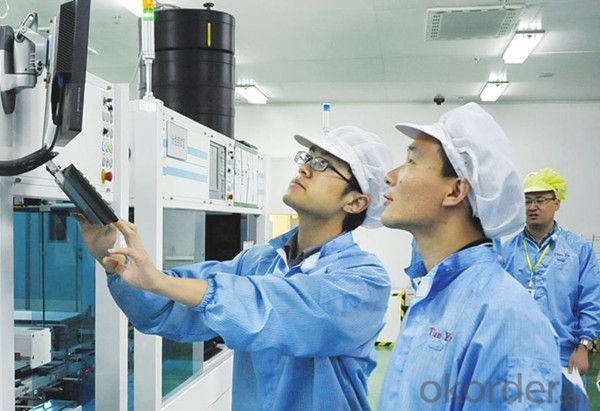

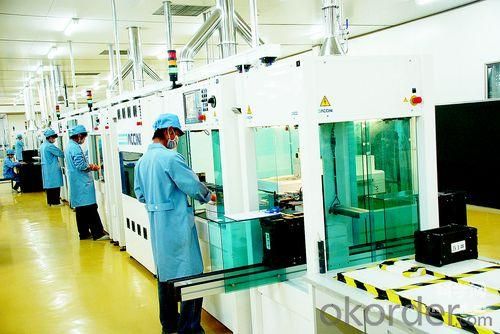
FAQ
We have organized several common questions for our clients,may help you sincerely:
1. What’s price per watt?
A: It’s depends on the quantity, delivery date and payment terms of the order. We can talk further about the detail price issue. Our products is high quality with lower price level.
2. Can you tell me the parameter of your solar cells?
We have different series of cells with different power output, both from c-si to a-si. Please take our specification sheet for your reference.
3. How do you pack your products?
We have rich experience on how to pack the panels to make sure the safety on shipment when it arrives at the destination.
4. Can you do OEM for us?
Yes, we can.
5. How long can we receive the product after purchase?
In the purchase of product within three working days, We will arrange the factory delivery as soon as possible. The perfect time of receiving is related to the state and position of customers. Commonly 7 to 10 working days can be served.
- Q: Can solar cells be used in high-altitude areas?
- Yes, solar cells can be used in high-altitude areas. In fact, solar cells can actually be more efficient at higher altitudes due to reduced atmospheric interference and increased solar irradiance. However, the performance of solar cells can still be affected by factors like temperature and snow cover, which need to be considered for optimal utilization in high-altitude regions.
- Q: Can solar cells be used in electric bikes or scooters?
- Yes, solar cells can be used in electric bikes or scooters. They can be integrated into the design of these vehicles to harness solar energy and supplement their charging systems. This enables them to recharge the battery and extend their overall range, making them more energy-efficient and sustainable transportation options.
- Q: How do solar cells perform in areas with high winds?
- Solar cells can generally perform well in areas with high winds, as they are designed to withstand various weather conditions. However, excessive wind speeds can potentially cause damage to the solar panels or the mounting structures, leading to reduced efficiency or even complete failure. Therefore, it is important to ensure that the solar panels are securely installed and that the mounting systems are designed to withstand the specific wind speeds of the area.
- Q: Many people said the usage of solar cell can reduce the cost overall, but does anyone agree with me that it actually cost a lot to operate a solar cell system?
- It cost less in terms of the energy waste.
- Q: Can solar cells be used in air conditioning systems?
- Yes, solar cells can be used in air conditioning systems. Solar cells can generate electricity from sunlight, which can then power the air conditioning unit, reducing the reliance on traditional energy sources and making the system more environmentally friendly and cost-effective.
- Q: How do solar cells perform in areas with high levels of noise pollution?
- Solar cells are not affected by noise pollution as they rely solely on sunlight to generate electricity, making them effective even in areas with high levels of noise pollution.
- Q: What is the role of voltage regulators in solar cell systems?
- The role of voltage regulators in solar cell systems is to ensure that the voltage output from the solar cells remains constant and within a specific range. They regulate the voltage to match the requirements of the connected devices or batteries, preventing overcharging or damage to the system. Voltage regulators also help maximize the efficiency of the solar cells by optimizing the power output.
- Q: How do solar cells impact national energy policies?
- Solar cells have a significant impact on national energy policies as they promote the diversification and decentralization of energy sources. By harnessing the power of the sun, solar cells contribute to the development of renewable energy and reduce reliance on fossil fuels. This, in turn, helps countries achieve their energy security goals, mitigate climate change, and enhance sustainability. Governments often incentivize the adoption of solar cells through policy measures such as feed-in tariffs, tax credits, and research funding, which further drive the growth of solar energy and shape national energy policies.
- Q: How does the size of a solar cell affect its performance?
- The size of a solar cell directly affects its performance. Generally, larger solar cells have the ability to generate more electricity compared to smaller ones. This is because larger cells have a greater surface area to capture sunlight, resulting in a higher conversion efficiency and increased power output. Additionally, larger cells are better at handling heat dissipation, which can improve their overall performance and durability.
- Q: How do solar cells perform in areas with extreme temperature fluctuations?
- Solar cells can be affected by extreme temperature fluctuations. High temperatures can cause solar cells to become less efficient and generate less electricity, while very low temperatures can reduce their ability to function optimally. However, advancements in technology and the use of materials that are more resistant to temperature changes have improved the performance of solar cells in areas with extreme temperature fluctuations. Additionally, proper installation and maintenance can help mitigate the impact of temperature fluctuations on solar cell performance.
Send your message to us
C Si Solar Cells - 25 Years Life Time - 17.8% Efficiency - World-Beating Performance
- Loading Port:
- Shanghai
- Payment Terms:
- TT OR LC
- Min Order Qty:
- 1000 pc
- Supply Capability:
- 5000000 pc/month
OKorder Service Pledge
OKorder Financial Service
Similar products
Hot products
Hot Searches
Related keywords



